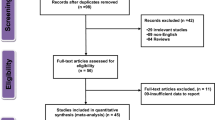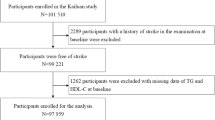Abstract
Purpose of Review
To systematically examine the association between low-density lipoprotein cholesterol (LDL-C) and risk of hemorrhagic stroke.
Recent Findings
A previous meta-analysis of prospective studies published in 2013 showed that higher concentrations of LDL-C were associated with lower risk of hemorrhagic stroke. Recently, seven large cohort studies were published examining LDL-C and risk of hemorrhagic stroke in different populations.
Summary
Twelve prospective studies with 476,173 participants and 7587 hemorrhagic stroke cases were included in the current meta-analysis. The results showed that a 10 mg/dL increase in LDL-C was associated with 3% lower risk of hemorrhagic stroke (pooled relative risk [RR] 0.97, 95% confidence interval [CI] 0.95–0.98). The association appeared to be more pronounced in Asians (pooled RR 0.95, 95% CI 0.92–0.98), relative to Caucasians (pooled RR 0.98, 95% CI 0.97–1.00), with a p heterogeneity of 0.05 between two ethnic groups. Further genetic studies and clinical trials with a stricter safety monitoring strategy are warranted to understand the underlying pathogenesis and determine the treatment target of LDL-C range with the lowest risk of hemorrhagic stroke in different population groups.


Similar content being viewed by others
References
Papers of particular interest, published recently, have been highlighted as: • Of importance •• Of major importance
Linton MRF, Yancey PG, Davies SS, et al. The role of lipids and lipoproteins in atherosclerosis. In: Feingold KR, Anawalt B, Boyce A, et al., editors. Endotext. South Dartmouth: MDText.com, Inc.; 2019. 2000-. Available from: https://www.ncbi.nlm.nih.gov/books/NBK343489/.
Feigin VL, Lawes CM, Bennett DA, Barker-Collo SL, Parag V. Worldwide stroke incidence and early case fatality reported in 56 population-based studies: a systematic review. Lancet Neurol. 2009;8(4):355–69. https://doi.org/10.1016/s1474-4422(09)70025-0.
Ikram MA, Wieberdink RG, Koudstaal PJ. International epidemiology of intracerebral hemorrhage. Curr Atheroscler Rep. 2012;14(4):300–6. https://doi.org/10.1007/s11883-012-0252-1.
Ariesen MJ, Claus SP, Rinkel GJ, Algra A. Risk factors for intracerebral hemorrhage in the general population: a systematic review. Stroke. 2003;34(8):2060–5. https://doi.org/10.1161/01.str.0000080678.09344.8d.
Amarenco P, Labreuche J. Lipid management in the prevention of stroke: review and updated meta-analysis of statins for stroke prevention. Lancet Neurol. 2009;8(5):453–63. https://doi.org/10.1016/s1474-4422(09)70058-4.
Report of the National Cholesterol Education Program Expert Panel on Detection, Evaluation, and Treatment of High Blood Cholesterol in Adults. The Expert Panel. Arch Intern Med. 1988;148(1):36-69.
Executive Summary of The Third Report of The National Cholesterol Education Program (NCEP) Expert Panel on Detection, Evaluation, And Treatment of High Blood Cholesterol In Adults (Adult Treatment Panel III). JAMA. 2001;285(19):2486-97.
Reiner Z, Catapano AL, De Backer G, Graham I, Taskinen MR, Wiklund O, et al. ESC/EAS Guidelines for the management of dyslipidaemias: the Task Force for the management of dyslipidaemias of the European Society of Cardiology (ESC) and the European Atherosclerosis Society (EAS). Eur Heart J. 2011;32(14):1769–818. https://doi.org/10.1093/eurheartj/ehr158.
Stone NJ, Robinson JG, Lichtenstein AH, Bairey Merz CN, Blum CB, Eckel RH, et al. 2013 ACC/AHA guideline on the treatment of blood cholesterol to reduce atherosclerotic cardiovascular risk in adults: a report of the American College of Cardiology/American Heart Association Task Force on Practice Guidelines. J Am Coll Cardiol. 2014;63(25 Pt B):2889–934. https://doi.org/10.1016/j.jacc.2013.11.002.
Nissen SE, Nicholls SJ, Sipahi I, Libby P, Raichlen JS, Ballantyne CM, et al. Effect of very high-intensity statin therapy on regression of coronary atherosclerosis: the ASTEROID trial. JAMA. 2006;295(13):1556–65. https://doi.org/10.1001/jama.295.13.jpc60002.
Giugliano RP, Wiviott SD, Blazing MA, De Ferrari GM, Park JG, Murphy SA, et al. Long-term safety and efficacy of achieving very low levels of low-density lipoprotein cholesterol: a prespecified analysis of the IMPROVE-IT Trial. JAMA Cardiol. 2017;2(5):547–55. https://doi.org/10.1001/jamacardio.2017.0083.
Rodriguez F, Maron DJ, Knowles JW, Virani SS, Lin S, Heidenreich PA. Association between intensity of statin therapy and mortality in patients with atherosclerotic cardiovascular disease. JAMA Cardiol. 2017;2(1):47–54. https://doi.org/10.1001/jamacardio.2016.4052.
Wang X, Dong Y, Qi X, Huang C, Hou L. Cholesterol levels and risk of hemorrhagic stroke: a systematic review and meta-analysis. Stroke. 2013;44(7):1833–9. https://doi.org/10.1161/strokeaha.113.001326.
• Judge C, Ruttledge S, Costello M, Murphy R, Loughlin E, Alvarez-Iglesias A, et al. Lipid lowering therapy, low-density lipoprotein level and risk of intracerebral hemorrhage—a meta-analysis. J Stroke Cerebrovasc Dis. 2019;28(6):1703–9. https://doi.org/10.1016/j.jstrokecerebrovasdis.2019.02.018 This is the most recent meta-analysis of clinical trials showing lipid lowering was associated with an increased risk of intracerebral hemorrhage in secondary prevention trials only; no association was observed in primary prevention trials.
Higgins JP, Thompson SG, Deeks JJ, Altman DG. Measuring inconsistency in meta-analyses. BMJ (Clin Res ed). 2003;327(7414):557–60. https://doi.org/10.1136/bmj.327.7414.557.
Greenland S, Longnecker MP. Methods for trend estimation from summarized dose-response data, with applications to meta-analysis. Am J Epidemiol. 1992;135(11):1301–9. https://doi.org/10.1093/571oxfordjournals.aje.a116237.
Orsini N, Li R, Wolk A, Khudyakov P, Spiegelman D. Meta-analysis for linear and nonlinear dose-response relations: examples, an evaluation of approximations, and software. Am J Epidemiol. 2012;175(1):66–73. https://doi.org/10.1093/aje/kwr265.
Liu Q, Cook NR, Bergström A, Hsieh C-C. A two-stage hierarchical regression model for meta-analysis of epidemiologic nonlinear 577 dose–response data. Comput Stat Data Anal. 2009;53(12):4157– 578 67. https://doi.org/10.1016/j.csda.2009.05.001.
Orsini N, Bellocco R, Greenland S. Generalized least squares for trend estimation of summarized dose–response data. Stata J. 581 2006;6(1):40–57. https://doi.org/10.1177/1536867X0600600103.
•• Ma C, Gurol ME, Huang Z, Lichtenstein AH, Wang X, Wang Y, et al. Low-density lipoprotein cholesterol and risk of intracerebral hemorrhage. Neurology. 2019;93(5):e445. https://doi.org/10.1212/WNL.0000000000007853 This is a prospective study after the most recent meta-analysis of prospective studies published in 2013.
•• Rist PM, Buring JE, Ridker PM, Kase CS, Kurth T, Rexrode KM. Lipid levels and the risk of hemorrhagic stroke among women. Neurology. 2019;92(19):e2286. https://doi.org/10.1212/WNL.0000000000007454 This is a prospective study after the most recent meta-analysis of prospective studies published in 2013.
•• Zhang X, Liu J, Wang M, Qi Y, Sun J, Liu J, et al. Twenty-year epidemiologic study on LDL-C levels in relation to the risks of atherosclerotic event, hemorrhagic stroke, and cancer death among young and middle-aged population in China. J Clin Lipidol. 2018;12(5):1179–89.e4. https://doi.org/10.1016/j.jacl.2018.06.011 This is a prospective study after the most recent meta-analysis of prospective studies published in 2013.
•• Stoekenbroek RM, Boekholdt SM, Luben R, Hovingh GK, Zwinderman AH, Wareham NJ, et al. Heterogeneous impact of classic atherosclerotic risk factors on different arterial territories: the EPIC-Norfolk prospective population study. Eur Heart J. 2016;37(11):880–9. https://doi.org/10.1093/eurheartj/ehv630 This is a prospective study after the most recent meta-analysis of prospective studies published in 2013.
•• Glasser SP, Mosher A, Howard G, Banach M. What is the association of lipid levels and incident stroke? Int J Cardiol. 2016;220:890–4. https://doi.org/10.1016/j.ijcard.2016.06.091 This is a prospective study after the most recent meta-analysis of prospective studies published in 2013.
Wieberdink RG, Poels MM, Vernooij MW, Koudstaal PJ, Hofman A, van der Lugt A, et al. Serum lipid levels and the risk of intracerebral hemorrhage: the Rotterdam Study. Arterioscler Thromb Vasc Biol. 2011;31(12):2982–9. https://doi.org/10.1161/atvbaha.111.234948.
Noda H, Iso H, Irie F, Sairenchi T, Ohtaka E, Doi M, et al. Low-density lipoprotein cholesterol concentrations and death due to intraparenchymal hemorrhage: the Ibaraki Prefectural Health Study. Circulation. 2009;119(16):2136–45. https://doi.org/10.1161/circulationaha.108.795666.
Imamura T, Doi Y, Arima H, Yonemoto K, Hata J, Kubo M, et al. LDL cholesterol and the development of stroke subtypes and coronary heart disease in a general Japanese population: the Hisayama study. Stroke. 2009;40(2):382–8. https://doi.org/10.1161/strokeaha.108.529537.
Holme I, Aastveit AH, Hammar N, Jungner I, Walldius G. Relationships between lipoprotein components and risk of ischaemic and haemorrhagic stroke in the Apolipoprotein MOrtality RISk study (AMORIS). J Intern Med. 2009;265(2):275–87. https://doi.org/10.1111/j.1365-2796.2008.02016.x.
Sturgeon JD, Folsom AR, Longstreth WT Jr, Shahar E, Rosamond WD, Cushman M. Risk factors for intracerebral hemorrhage in a pooled prospective study. Stroke. 2007;38(10):2718–25. https://doi.org/10.1161/strokeaha.107.487090.
Psaty BM, Anderson M, Kronmal RA, Tracy RP, Orchard T, Fried LP, et al. The association between lipid levels and the risks of incident myocardial infarction, stroke, and total mortality: the Cardiovascular Health Study. J Am Geriatr Soc. 2004;52(10):1639–47. https://doi.org/10.1111/j.1532-5415.2004.52455.x.
•• Sun L, Clarke R, Bennett D, Guo Y, Walters RG, Hill M, et al. Causal associations of blood lipids with risk of ischemic stroke and intracerebral hemorrhage in Chinese adults. Nat Med. 2019;25(4):569–74. https://doi.org/10.1038/s41591-019-0366-x This is a prospective study after the most recent meta-analysis of prospective studies published in 2013.
•• Zheng J, Sun Z, Zhang X, Li Z, Guo X, Xie Y, et al. Non-traditional lipid profiles associated with ischemic stroke not hemorrhagic stroke in hypertensive patients: results from an 8.4 years follow-up study. Lipids Health Dis. 2019;18(1):9. https://doi.org/10.1186/s12944-019-0958-y This is a prospective study after the most recent meta-analysis of prospective studies published in 2013.
van Asch CJ, Luitse MJ, Rinkel GJ, van der Tweel I, Algra A, Klijn CJ. Incidence, case fatality, and functional outcome of intracerebral haemorrhage over time, according to age, sex, and ethnic origin: a systematic review and meta-analysis. Lancet Neurol. 2010;9(2):167–76. https://doi.org/10.1016/s1474-4422(09)70340-0.
Karthikeyan G, Teo KK, Islam S, McQueen MJ, Pais P, Wang X, et al. Lipid profile, plasma apolipoproteins, and risk of a first myocardial infarction among Asians: an analysis from the INTERHEART Study. J Am Coll Cardiol. 2009;53(3):244–53. https://doi.org/10.1016/j.jacc.2008.09.041.
Firestone MJ, Beasley JM, Kwon SC, Ahn J, Trinh-Shevrin C, Yi SS. Asian American Dietary sources of sodium and salt behaviors compared with other racial/ethnic groups, NHANES, 2011-2012. Ethn Dis. 2017;27(3):241–8. https://doi.org/10.18865/ed.27.3.241.
Bruckdorfer KR, Demel RA, De Gier J, van Deenen LL. The effect of partial replacements of membrane cholesterol by other steroids on the osmotic fragility and glycerol permeability of erythrocytes. Biochim Biophys Acta. 1969;183(2):334–45.
Rosenson RS, Lowe GD. Effects of lipids and lipoproteins on thrombosis and rheology. Atherosclerosis. 1998;140(2):271–80.
Lee SH, Bae HJ, Yoon BW, Kim H, Kim DE, Roh JK. Low concentration of serum total cholesterol is associated with multifocal signal loss lesions on gradient-echo magnetic resonance imaging: analysis of risk factors for multifocal signal loss lesions. Stroke. 2002;33(12):2845–9.
Kim DE, Bae HJ, Lee SH, Kim H, Yoon BW, Roh JK. Gradient echo magnetic resonance imaging in the prediction of hemorrhagic vs ischemic stroke: a need for the consideration of the extent of leukoariosis. Arch Neurol. 2002;59(3):425–9.
Greenberg SM, Rebeck GW, Vonsattel JP, Gomez-Isla T, Hyman BT. Apolipoprotein E ε4 is associated with the presence and earlier onset of hemorrhage in cerebral amyloid angiopathy. Ann Neurol. 1995;38:254–9.
Greenberg SM, Briggs ME, Hyman BT, Kokoris GJ, Takis C, Kanter DS, et al. Apolipoprotein E epsilon 4 is associated with the presence and earlier onset of hemorrhage in cerebral amyloid angiopathy. Stroke. 1996;27(8):1333–7.
Biffi A, Sonni A, Anderson CD, Kissela B, Jagiella JM, Schmidt H, et al. Variants at APOE influence risk of deep and lobar intracerebral hemorrhage. Ann Neurol. 2010;68(6):934–43. https://doi.org/10.1002/ana.22134.
Phuah CL, Raffeld MR, Ayres AM, Gurol ME, Viswanathan A, Greenberg SM, et al. APOE polymorphisms influence longitudinal lipid trends preceding intracerebral hemorrhage. Neurol Genet. 2016;2(4):e81. https://doi.org/10.1212/nxg.0000000000000081.
Author information
Authors and Affiliations
Corresponding author
Ethics declarations
Conflict of Interest
Chaoran Ma, Muzi Na, Samantha Neumann, and Xiang Gao declare they have no conflict of interest.
Human and Animal Rights and Informed Consent
This article does not contain any studies with human or animal subjects performed by any of the authors.
Additional information
Publisher’s Note
Springer Nature remains neutral with regard to jurisdictional claims in published maps and institutional affiliations.
This article is part of the Topical Collection on Nutrition
Electronic supplementary material
ESM 1
(DOCX 23 kb)
Rights and permissions
About this article
Cite this article
Ma, C., Na, M., Neumann, S. et al. Low-Density Lipoprotein Cholesterol and Risk of Hemorrhagic Stroke: a Systematic Review and Dose-Response Meta-analysis of Prospective Studies. Curr Atheroscler Rep 21, 52 (2019). https://doi.org/10.1007/s11883-019-0815-5
Published:
DOI: https://doi.org/10.1007/s11883-019-0815-5




